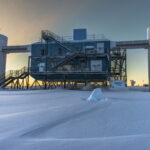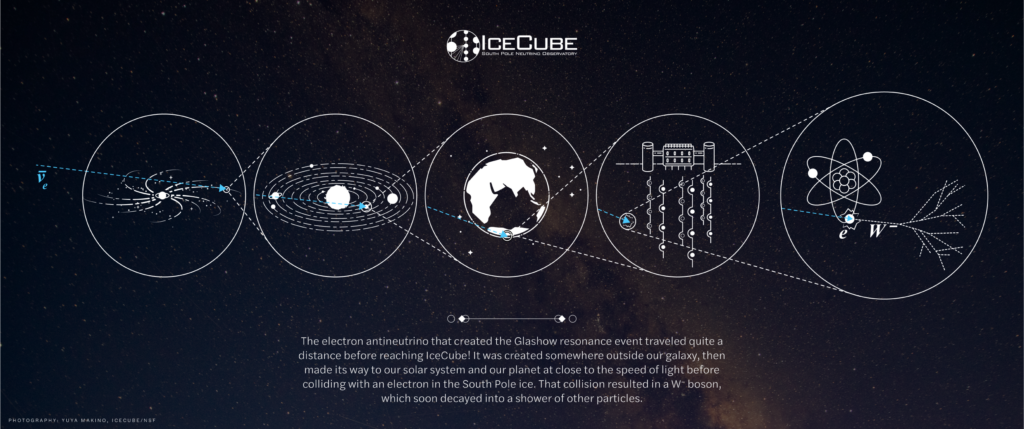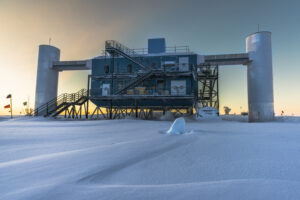
IceCube detection of a high-energy particle proves 60-year-old theory
On December 8, 2016, a high-energy particle called an electron antineutrino hurtled to Earth from outer space at close to the speed of light carrying 6.3 petaelectronvolts (PeV) of energy. Deep inside the ice sheet at the South Pole, it smashed into an electron and produced a particle that quickly decayed into a shower of secondary particles. The interaction was captured by a massive telescope buried in the Antarctic glacier, the IceCube Neutrino Observatory.

The electron antineutrino that created the Glashow resonance event traveled quite a distance before reaching IceCube. This graphic shows its journey; the blue dotted line is the antineutrino’s path. (Not to scale.) (Credits: IceCube Collaboration)
IceCube had seen a Glashow resonance event, a phenomenon predicted by Nobel laureate physicist Sheldon Glashow in 1960. With this detection, scientists provided another confirmation of the Standard Model of particle physics. It also further demonstrated the ability of IceCube, which detects nearly massless particles called neutrinos using thousands of sensors embedded in the Antarctic ice, to do fundamental physics. The result was published on March 10 in Nature.
“This result proves the feasibility of neutrino astronomy—and IceCube’s ability to do it—which will play an important role in future multimessenger astroparticle physics,” says Christian Haack, who was a graduate student at RWTH Aachen while working on this analysis. “We now can detect individual neutrino events that are unmistakably of extraterrestrial origin.”
Since IceCube started full operation in May 2011, the observatory has detected hundreds of high-energy astrophysical neutrinos and has produced a number of significant results in particle astrophysics, including the discovery of an astrophysical neutrino flux in 2013 and the first identification of a source of astrophysical neutrinos in 2018. But the Glashow resonance event is especially noteworthy because of its remarkably high energy; it is only the third event detected by IceCube with an energy greater than 5 PeV.
To confirm the detection and make a decisive measurement of the neutrino-to-antineutrino ratio, the IceCube Collaboration wants to see more Glashow resonances. A proposed expansion of the IceCube detector, IceCube-Gen2, would enable the scientists to make such measurements in a statistically significant way. The collaboration recently announced an upgrade of the detector that will be implemented over the next few years, the first step toward IceCube-Gen2.

The IceCube Laboratory at the South Pole. This building holds the computer servers that collect data from IceCube’s sensors under the ice. (Credits: Martin Wolf, IceCube/NSF)
Glashow, now an emeritus professor of physics at Boston University, echoes the need for more detections of Glashow resonance events. “To be absolutely sure, we should see another such event at the very same energy as the one that was seen,” he says. “So far there’s one, and someday there will be more.”
“The detection of this event is another ‘first,’ demonstrating yet again IceCube’s capacity to deliver unique and outstanding results,” says Olga Botner, professor of physics at Uppsala University in Sweden and former spokesperson for the IceCube Collaboration.
Last but not least, the result demonstrates the value of international collaboration. IceCube is operated by over 400 scientists, engineers, and staff from 53 institutions in 12 countries, together known as the IceCube Collaboration. The main analyzers on this paper worked together across Asia, North America, and Europe.
The IceCube Neutrino Observatory is funded primarily by the US National Science Foundation but also with significant European contributions. Research at IceCube, including major contributions to the construction and operation of the detector, is supported in Europe by funding agencies from Belgium, Denmark, Germany, Sweden, Switzerland, and the United Kingdom.
See full press release here: https://icecube.wisc.edu/news/press-releases/2021/03/icecube-detection-of-a-high-energy-particle-proves-60-year-old-theory/
Further information:
- Detection of a particle shower at the Glashow resonance with IceCube, The IceCube Collaboration: R. Abbasi et al. Nature (https://dx.doi.org/10.1038/s41586-021-03256-1)
- IceCube website: https://icecube.wisc.edu/



